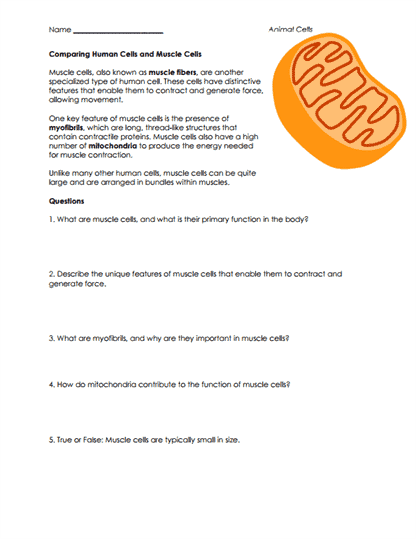Comparing Human Cells and Muscle Cells

Worksheet Description
The worksheet offers an exploration into the unique attributes and functions of muscle cells, also termed muscle fibers, when contrasted with other human cell types. It underscores the specialized nature of these cells, emphasizing their capability to contract and produce movement. Key structural characteristics, such as the presence of myofibrils and the significant number of mitochondria in muscle cells, are highlighted. Through a series of questions, students are prompted to delve deeper into the defining features and significance of muscle cells.
To proficiently engage with this worksheet, students should first immerse themselves in the initial descriptive section, ensuring they grasp the nuanced differences between muscle cells and other human cells. The accompanying illustration can serve as a visual aid, facilitating the correlation of textual descriptions with the cell’s actual appearance. After digesting the provided information, students should tackle the questions, using the main text as a foundational reference for crafting accurate answers. Reviewing their responses against the main content upon completion will solidify their comprehension and clarify any misconceptions.
This worksheet aims to equip students with a comprehensive understanding of muscle cells’ distinct characteristics and their pivotal role in the human body. By elaborating on specific features, such as myofibrils, it enlightens students on the mechanisms that enable muscle contraction and movement. Furthermore, the content emphasizes the critical contribution of mitochondria in supplying the energy required for muscle function. Through the posed questions, students are challenged to apply and reinforce their knowledge, ensuring they appreciate the complexities and importance of muscle cells in physiological processes.
